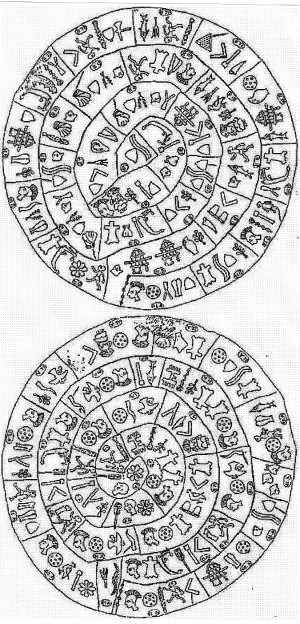 |  |
|
|
||||||||||
|
Alan Butler and 366-degree geometry
In the course of my research I read the book of a British author named Alan Butler. In his book, entitled The Bronze Age Computer Disc, published in Britain in 1999, Butler demonstrated that the Phaistos Disc, a small red clay artefact found in Crete and dating back to nearly 4,000 years, was an elaborate calendar based on a 366-day year. Butler had also had a brilliant hunch - that the Minoan (from Minos, a semi-legendary king of ancient Crete) calendar might have led to the creation of a 366-degree geometry. If the Minoans indeed divided their year into 366 days, it was possible they had also divided the skies - and thus the circle - into 366 parts. This 366-degree geometry could even have been at the origin of our own 360-degree geometry. 
Butler found two pieces of evidence that this geometry had indeed existed: the Minoan foot, the unit of measurement of the ancient Cretans, and the Megalithic yard, the presumed unit of measurement of the Megalithic people, both were very accurate subdivisions of the Earth circumference within 366-degree geometry. To cut a long story short, the Minoan second of arc (which was also probably the Megalithic second of arc too) equalled 1,000 Minoan feet or 366 Megalithic yards exactly - results that couldn't be explained by mere chance and that showed these people knew the Earth was spherical. They also knew about its exact dimensions. There was just no other rational explanation. To sum things up, 6 seconds of arc equalled 1 minute of arc, 60 minutes of arc equalled 1 degree, and 366 degrees equalled the Earth circumference. To measure up time the Megalithic people could have used a pendulum with a length of 1/2 Megalithic yard which, by a funny coincidence (?) indeed, produces 366 beats in one 366th of a day. If true, it meant that these people of late prehistory or early antiquity were excellent mathematicians and brilliant astronomers. The pieces of the puzzle started to fit into one another. When I finished reading Alan Butler's book I sent him an email. To my amazement Alan at once sent me a detailed, four-page reply. An intense correspondence was engaged, and a great friendship was born. But Alan hadn't told me the whole story yet. He soon explained me that the Megalithic people were already familiar with a system of meridians and parallels similar to that we use today, with the difference that their system didn't use 360 lines but 366, of course. I must confess that, at this moment, I almost thought Alan wasn't serious... |
